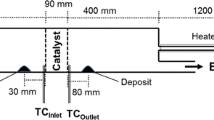Abstract
The catalyst for diesel ultra-deep desulfurization is selected on the basis of several factors, including feedstock composition, liquid hourly space velocity, and operation pressure. Owing to their specific processing purposes, different catalyst systems, such as straight distillation, coking distillation, blends of straight distillation, and secondary processing oil, are applied for various feeds because of their considerable difference in terms of sulfur content, nitrogen content, aromatics constitute, and cetane number. This study aims to determine the most appropriate catalyst and grading scheme by evaluating the deep desulfurization efficiency of different schemes when processing various feeds. The results showed that the W–Mo–Ni/Mo–Co catalyst stacking is the most effective among various schemes because of the following reasons: (1) loading W–Mo–Ni catalyst on the upper bed of reactor not only benefits the saturation of polyaromatics even in the middle or at the end of the run but also provides low nitrogen feed for the bottom bed; (2) loading Mo–Co type catalyst with alkyl transfer performance in the bottom bed at high temperature reaction zone facilitates alkyl transfer reaction and mitigates the effect of thermodynamic equilibrium limitations in the middle and at the end of the run, consequently improving the HDS efficiency under high temperatures.
Graphical Abstract





Similar content being viewed by others
References
Zhang X, Guo A, Wang F, Duan X (2010) Directly producing clean and low softening point diesel using integrated hydrotreating and hydroisomerizing catalysts†. Energy Fuels 24(7):3772–3777
Marafi A, Al-Hindi A, Stanislaus A (2007) Deep desulfurization of full range and low boiling diesel streams from Kuwait Lower Fars heavy crude. Fuel Process Technol 88(9):905–911
Wang S, Yin Q, Guo J, Zhu L (2013) Influence of Ni promotion on liquid hydrocarbon fuel production over Co/CNT catalysts. Energy Fuels 27(7):3961–3968
Schacht P, Ramírez S, Ancheyta J (2009) CoMo/Ti-MCM-41/alumina catalysts: properties and activity in the hydrodesulfurization (HDS) of dibenzothiophene (DBT). Energy Fuels 23(10):4860–4865
Al-Dalama K, Stanislaus A (2006) A comparative study of the influence of chelating agents on the hydrodesulfurization (HDS) activity of alumina and silica–Alumina-supported CoMo catalysts. Energy Fuels 20(5):1777–1783
Li Y, Liu D, Liu C (2009) Hydrodesulfurization (HDS) and hydrodenitrogenation (hdn) performance of an ex situ presulfided MoNiP/Al2O3 catalyst: model compounds study and pilot test for fluidized catalytic cracking (FCC) diesel oil. Energy Fuels 24(2):789–795
Shen H, Shen B, Ling H (2013) Desulfurization of fluid catalytic cracking gasoline by extractive distillation coupled with hydrodesulfurization of heavy fraction. Energy Fuels 27(9):5153–5160
Perot G (2003) Hydrotreating catalysts containing zeolites and related materialsmechanism aspects related to deep desulfurization. Catal Today 86(1–4):111–128
Shafi R, Hutchings GJ (2000) Hydrodesulfurization of hindered dibenzothiophenes: an overview. Catal Today 59(3–4):423–442
Bataille F, Lenibcrton JL, Michanct P et al (2000) Alkyldibenzothiophenes hydrodesulfurization-promoter effect, reactivity, and reaction mechanism. J Catal 191(2):409–422
Topsoe H, Clausen BS (1996) MASSOTH F E. In: Anderson JR, Boudart M (eds) Hydrotreating catalysis-science and technology, vol 11. Springer, Berlin
Egorova M, Prins R (2004) Hydrodesulfurization of dibenzothiophene and 4,6-dimethyldibenzothiophene over sulfided NiMo/γ-Al2O3, CoMo/γ-Al2O3, and Mo/γ-Al2O3 catalysts. J Catal 225(2):417–427
Olsen CW, David K (2005) Custom catalyst systems for meeting ULSD regulations. In: NPRA annual meeting, AM-05-17, San Francisco, USA
Olsen CW, D’Angelo G (2006) No need to trade ULSD catalyst performance for hydrogen limits: SmART approaches. In: NPRA annual meeting, AM-06-06, Salt Lake City, USA
Mayo S, Leliveld B (2009) Experiences in maximizing performance of ULSD units. In: NPRA annual meeting, AM-09-14, San Antonio, USA
Mayo S, Vogt K, Leliveld B et al (2010) Crossing frontiers in the performance and economic return of ULSD units. In: NPRA annual meeting, AM-10-170, Phoenix, Arizona, USA
Mayo S (2011) Successful production of ULSD in low pressure hydrotreaters. In: NPRA annual meeting, AM-11-23, San Antonio, USA
Topsøe H, Cooper BH, Knudsen KG (2005) ULSD with BRIM™ catalyst technology. In: NPRA annual meeting, AM-05-18, San Francisco, USA
Nocca J-L, Dorbon M (2003) Ultra-low sulfur diesel with the prime-D technology package. In: NPRA annual meeting, AM-03-25, San Antonio, USA
Stanislaus A, Marafi A, Rana MS (2010) Recent advances in the science and technology of ultra low sulfur diesel (ULSD) production. Catal Today 153(1–2):1–68
Shiraishi Y, Tachibana K, Hirai T, Komasawa I (2001) A novel desulfurization process for fuel oils based on the formation and subsequent precipitation of s-alkylsulfonium salts. 5. Denitrogenation Reactivity of Basic and Neutral Nitrogen Compounds. Ind Eng Chem Res 40(22):4919–4924
Shiraishi Y, Tachibana K, Hirai T, Komasawa I (2001) A novel desulfurization process for fuel oils based on the formation and subsequent precipitation of s-alkylsulfonium salts. 3. Denitrogenation behavior of light oil feedstocks. Ind Eng Chem Res 40(15):3390–3397
Georgina CLS, Adlrh J, Jlc D, Jjc M (2001) Inhibition effects of nitrogen compounds on the hydrodesulfurization of dibenzothiophene. Appl Catal A Gen 207:103–112
Author information
Authors and Affiliations
Corresponding author
Rights and permissions
About this article
Cite this article
Peng, C., Guo, R. & Fang, Xc. Improving Ultra-Deep Desulfurization Efficiency by Catalyst Stacking Technology. Catal Lett 146, 701–709 (2016). https://doi.org/10.1007/s10562-015-1675-4
Received:
Accepted:
Published:
Issue Date:
DOI: https://doi.org/10.1007/s10562-015-1675-4



